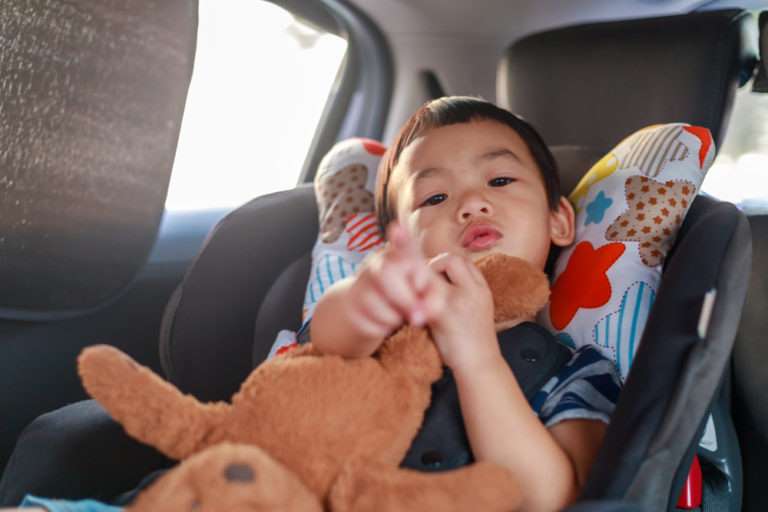Nevada Car Seat Laws
November 22, 2022

Per the Nevada Department of Motor Vehicles (DMVNV), children are expected to use car seats until they are seven years old. However, this age is subject to change based on the child’s size; it depends on when they are big enough to wear a seat belt. They also must sit in the back seat until they are 12 years old.
Continue reading to learn more about Nevada’s car seat laws and what you can do to keep your child safe.
Best Practices for Passengers who are Children Under the Age of 12
NRS §484B.157 says that any child under the age of six who weighs less than 60 pounds must use a car seat. The car seat must be approved by the state.
Some safety practices depending on your child’s age are as follows:
- Birth to 12 months. Your child must use a rear-facing car seat.
- One to three years. Ideally, your child should use a rear-facing car seat for as long as possible. However, once they are too big for this arrangement, they should use a front-facing seat with a harness.
- Four to seven years. Once your child has outgrown their car seat, they should use a booster seat until they are large enough to use a seat belt.
- Eight to 12 years. Your child should use a seat belt. It must fit across their thighs, not their stomach. The shoulder belt should also go across their chest, not their face or neck.
Once your child is a teenager, they can sit in the front seat and wear a seat belt as an adult would.
Children are Prohibited From Riding in Pick-Up Truck Beds
In the words of the Nevada Department of Motor Vehicles: “Children are not cargo.” Per NRS §484B.160, children under the age of 18 are prohibited from riding in the flatbeds of pick-up trucks. This does not pertain to farming activity, parades, and ranching activity.
Why Does My Child Need to Sit in the Back Seat?
The American Academy of Pediatrics says that while airbags save hundreds of lives each year, they can hurt children. When they deploy, airbags can cause face, neck, and head injuries to small children. They can also cause broken bones, internal bleeding, and other health complications.
If your child must ride in the front seat, you should turn off your airbags. However, this is only recommended if your child requires constant supervision or has a health concern that prevents them from riding in the backseat.
You Could Face Penalties if Your Child is not Properly Secured
If your child is not properly secured in a car seat, you could face the following consequences, per NRS §484B.157:
- If this is your first offense, you could face a fine anywhere from $100 to $500. You could also be sentenced to 10 to 50 hours of community service.
- If this is your second offense, you could face a fine of $500 to $1,000. You may also face anywhere from 50 to 100 hours of community service.
- If this is your third offense, your license could be suspended for 30 to 180 days.
What Happens if Your Child was Hurt in an Accident and they Weren’t in a Car Seat?
Any car accident case involving children can get complicated. If you were injured in an accident, and your child wasn’t in a car seat, you can work with a lawyer from our firm. We can determine if you qualify to recover compensation. If so, then we can help hold the other party accountable for your losses.
Do not let the other party say that because your child wasn’t in a car seat, you cannot collect compensation. If they caused the accident, they should pay for your losses––plain and simple.
Steps to Take Following a Car Accident That Harmed Your Child
The National Highway Traffic Safety Administration (NHTSA) says that if you were involved in a major car accident, you should replace your child’s car seat with a new one. The force of impact may have compromised the integrity of the car seat, and it may no longer be safe for use.
Following a collision, you should also:
- Take your child to a healthcare provider and check for injuries.
- Document all losses from the crash.
- Take photos of your child’s injuries (as well as your own) and your vehicle’s damage.
- Notify your insurance company.
You should also consider how our firm can manage the claims process for you. Your time to act may be limited under NRS §11.190(4)(e), so we encourage you to connect with our team as soon as possible.
Call the Attorneys at High Stakes Injury Law to Learn More About Nevada’s Car Seat Laws
If you or a loved one was hurt in a car accident, our team is prepared to help you recover compensation. We have over 60 years of combined legal experience, and we have secured seven-figure settlements for our clients.
To begin your free case review with our Nevada law firm, call today.
Get A 100% Free Case Evaluation
From A Top-Rated Personal Injury Attorney
Call: (702) 707-5934 or Contact Us Online
$9M
Settlement / Auto Accident
$5.1M
Settlement / Tire Explosion
$3M
Settlement / Truck Accident
01
02
03
04

I Was Injured In An Accident.
What Do I Do Now?
By Scott L. Poisson

Do I Have A Case?

Dealing With The Insurance Company

When a Lawsuit Is Filed

Overcoming Common Defense Themes

Special Considerations in Specific Types of Cases
